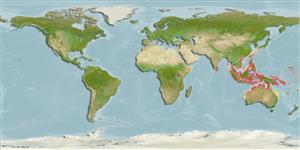Environment: milieu / climate zone / depth range / distribution range
Ecología
marino asociado a arrecife; rango de profundidad 2 - 25 m (Ref. 90102). Tropical
Indo-West Pacific: ranges from the Indo-Malay Archipelago to New Guinea and Solomon Islands.
Tamaño / Peso / Age
Maturity: Lm ? range ? - ? cm
Max length : 10.0 cm TL macho / no sexado; (Ref. 48635)
Espinas dorsales (total): 8; Radios blandos dorsales (total): 9; Espinas anales 2; Radios blandos anales: 8. Adults with orange spots on cheek (Ref. 48635).
Found in coral reefs, more commonly in aggregations among branching corals (Ref. 36661, 48635).
Life cycle and mating behavior
Madurez | Reproducción | Puesta | Huevos | Fecundidad | Larva
Mouthbrooders (Ref. 240). Distinct pairing during courtship and spawning (Ref. 205).
Fraser, T.H., 2012. A new species of deeper dwelling West Pacific cardinalfish (Percomorpha: Apogonidae) with a redescription of Ostorhinchus atrogaster. Zootaxa 3492:77-84. (Ref. 91763)
IUCN Red List Status (Ref. 130435)
Threat to humans
Harmless
Human uses
Más información
ReferenciasAcuiculturaPerfil de acuiculturaRazasGenéticaElectrophoresesheritabilidadEnfermedadesProcesamientoNutrientsMass conversion
ColaboradoresImágenesStamps, Coins Misc.SonidosCiguateraVelocidadTipo de nataciónSuperficie branquialOtolitosCerebrosVisión
Herramientas
Special reports
Download XML
Fuentes de Internet
Estimates based on models
Preferred temperature (Ref.
123201): 26.1 - 29.2, mean 28.7 °C (based on 1530 cells).
Phylogenetic diversity index (Ref.
82804): PD
50 = 0.5000 [Uniqueness, from 0.5 = low to 2.0 = high].
Bayesian length-weight: a=0.01122 (0.00528 - 0.02384), b=3.10 (2.92 - 3.28), in cm total length, based on LWR estimates for this (Sub)family-body shape (Ref.
93245).
Nivel trófico (Ref.
69278): 3.5 ±0.4 se; based on size and trophs of closest relatives
Resiliencia (Ref.
120179): Alto, población duplicada en un tiempo mínimo inferior a 15 meses (Preliminary K or Fecundity.).
Fishing Vulnerability (Ref.
59153): Low vulnerability (10 of 100).
Nutrients (Ref.
124155): Calcium = 144 [88, 265] mg/100g; Iron = 1.05 [0.62, 1.66] mg/100g; Protein = 19.1 [18.0, 20.1] %; Omega3 = 0.166 [0.100, 0.275] g/100g; Selenium = 28.8 [15.1, 53.5] μg/100g; VitaminA = 88.3 [31.2, 247.0] μg/100g; Zinc = 2.02 [1.36, 2.86] mg/100g (wet weight);
